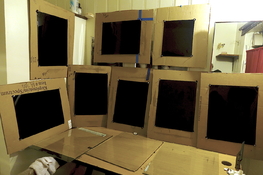Do no sweep, push or vacuum the darkroom, for 99% of cleaning.
A small HEPA Vacuum made for keyboards, etc when needed but otherwise use swifter wet mops only keeping big things in the front of the direction of the push or pull action.
You might have some dirt remaining but a second wet mop should take care of that.
Steam cleaning is great, when it's no blowing dust and dirt up into the air and, if you can, use a good mister to first 'drop' a fine layer of water onto the area being cleaned.
This should also help with Swifter wet mopping.
I also suggest you most/damp sinks as many chemistries dry to a crust or powder and that can be even worse than regular dust.
The same thing with trays, cylinders, reels, etc, as some chemicals will dry out and leave residue in the corner of a developing tank, for example.
A thin sanitary pad or half of one can apply be used with CLR, to remove rust from hardware and hardware minerals from utensils, as needed.
I like Simply Green for a general cleaner and Harbor Freight Microfiber towels for smooth surfaces, such as a laminated, metal, or painted shelf or table.
Rinse those surfaces with water to remove residue.
My Darkroom is almost always cluttered, but when I clean, it's with an eye no to share any dust or chemical around and these are things I've learned to do whenever I do tidy-up, in general.
This includes washing up well when a developing or printing session is done, something I got into the habit of doing right away when I did darkroom for others photographers, in part because when you are dirtying up sheet film holders, rubber and steel tanks, spiral reels and their tanks, etc and the darkroom has a limited supply when hundreds of spools, and sheets of film to be processed, you need them washed and completely dry, NOW!
Printing trays, measuring tools, and various hardware, including tongs, stirs, and thermometers also are washed up right away, again, after the session is over.
Godspeed and Happy printing to all our darkroom brothers and sisters!
Eli













